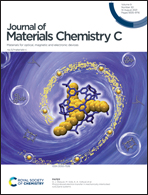Highly luminescent InP–In(Zn)P/ZnSe/ZnS core/shell/shell colloidal quantum dots with tunable emissions synthesized based on growth-doping†
Abstract
InP quantum dots (QDs) are considered as the most promising alternative to Cd-based QDs with lower toxicity, and emission spectrum tunability ranging from the visible to near-infrared region. Although high-quality fluorescent InP QDs have been successfully synthesized by several groups, the rigorous synthesis conditions hinder its practical use in display devices. In this work, for the first time, we introduce Zn2+ into the growth stage of the InP QDs to prepare an InP–In(Zn)P core, and then the as-grown InP–In(Zn)P cores were consecutively coated with typical double shells of inner ZnSe and outer ZnS. The final InP–In(Zn)P/ZnSe/ZnS core/shell/shell QDs exhibited a maximum photoluminescence (PL) quantum yield (QY) of 94.3% and have tunable emissions from yellow (569 nm) to red (630 nm), showing a potential application in display devices. Above all, compared with other related studies, the excellent PL properties were obtained in relatively milder conditions (ultimate vacuum level of 400 mTorr). The results of this study provide guidance for the commercial application of InP QDs as a viable alternative to Cd-based QDs.



 Please wait while we load your content...
Please wait while we load your content...